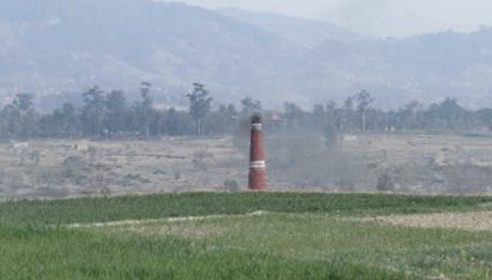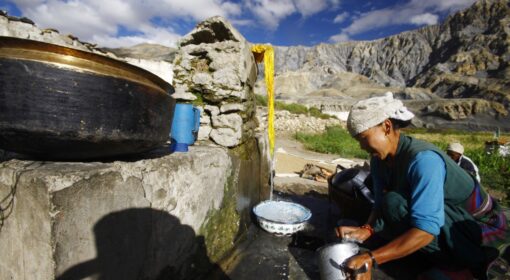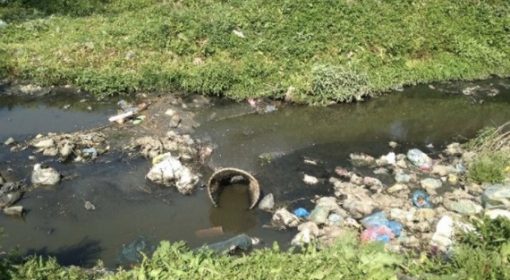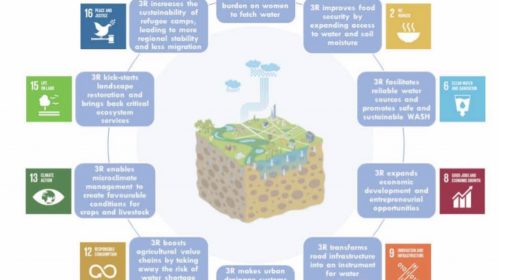Water Scarcity as a Business in Kathmandu Valley, Nepal
December 2016, Otto Hoffman
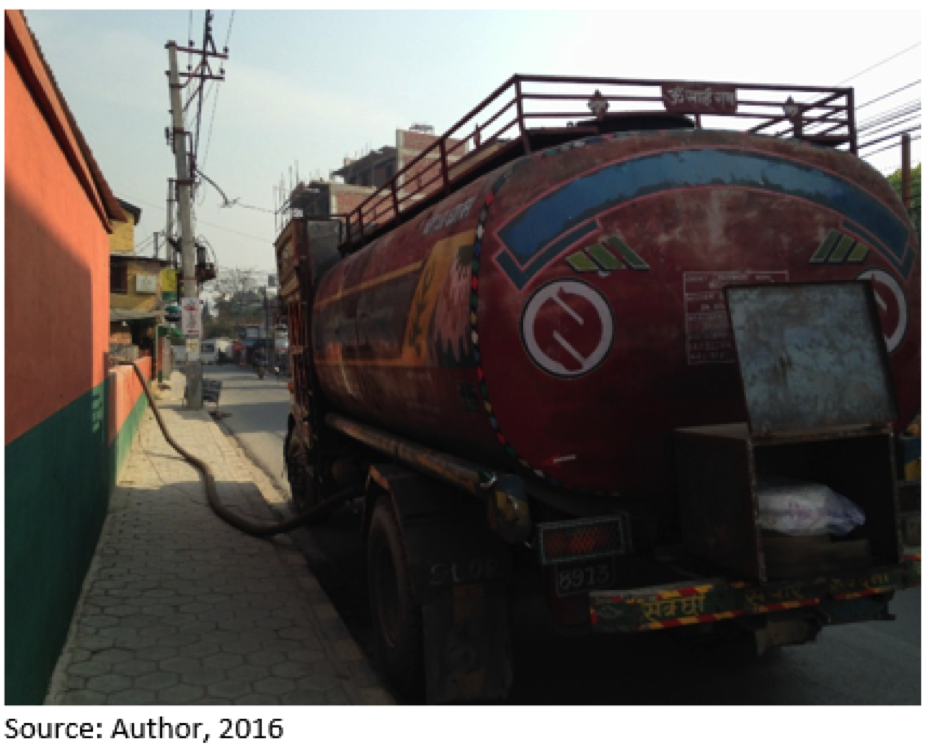 Nepal is blessed with an abundance of water throughout the country in the form of snow cover, glaciers, springs, rivers, lakes and groundwater and is considered as among one of the richest countries in terms of water resources in the world. Despite being blessed, many communities lack potable water. Water is not scare but management is poor – for everyone to get a fair price.
Nepal is blessed with an abundance of water throughout the country in the form of snow cover, glaciers, springs, rivers, lakes and groundwater and is considered as among one of the richest countries in terms of water resources in the world. Despite being blessed, many communities lack potable water. Water is not scare but management is poor – for everyone to get a fair price.
Having asked local people’s experience – ‘water governance is essential for sustainable development’. Kathmandu Valley – residents of peri-urban areas in Kathmandu, Laliptur and Bhaktapur are facing water shortages due to urbanization and over-exploitation of groundwater resources. The balance between water supplies and human needs has come under increasing threat due to the growing population, urbanization, and the uncertainty in water availability, which is likely to increase under climate change. Shallow and deep wells on average experience falling groundwater levels between 2.5 – 4 meters, respectively (Shrestha, 2007; 2012). Given that, one wonders if the current situation is sustainable for the growth of the cities.
Kathmandu Upatyaka Khanepani Limited (KULK) or Kathmandu Municipal Water Supply solely depends on surface water sources and deep tube wells from peri-urban areas and beyond. However, KULK can’t meet the current and future demand of the growing urbanization in the valley, especially during the dry season. The frequent shortage of water supply and climate change have continued to affect thousands of people in both urban and peri-urban settings.
The shortage of water left by the combined services of traditional sources and piped water supply has, however, become good news for some, as it has encouraged the emergence of groundwater markets, like water tankers who have made a profession or business to support their livelihoods.
As a result of the water demand gap experienced in Kathmandu Valley, this led to a growing emergence of water businesses, both, private and state-run entities to fill the gap to meet the water demand. Also, the growing urban areas have increased the water transfers from peri-urban to urban areas. Studies have shown that over 90% of private water tanker businesses in Kathmandu Valley are extracting groundwater resources from peri-urban areas (Shrestha, 2011; Shrestha et al., 2013). Emerging conflicts and cooperation’s between water tankers, communities and the local government have emanated due to the high water stresses.
Water Tanker business
The emergence of water tanker businesses has some advantages providing water to places that can’t have water, and yet the over exploitation from other places is creating problems. People who have money can rely on having water.
Speaking to a local middle-class family residing in Lalitpur, they explained that they spend 1000 Nepalese Rupee’s per month on water. The head of the household further explains that “water provided by the government only comes for 30 – 45 minutes every day and if there’s no power then you won’t even get a drop. And when we do get the water, it only lasts for a day. So we have to buy water from the water tankers provided by a private company which costs 1500 Nepalese Rupees per 5000 liters and it lasts for 15 to 25 days”.
According to Dongol et al., (2012), water tankers operate at different levels: the individual level (profit based), the community level (service based) and the commercial level (profit based). The water tanker business operating at the commercial level contributes to the largest volume of water transfer creating extensive challenges. Water tankers provide a service to a range of consumers such as private residents, hotels, restaurants, schools, construction works, pharmaceutical industries, and soft drink manufacturers.
In the midst of the water scarcity in the valley, water tankers generally want to extract water in an unregulated manner, whilst their interest is to make profit and to have control over the water resources in peri-urban areas. Over time this contributed to employment and a new (additional) source of income to sustain livelihoods. Conversely, a play – related to profit rather than service has emerged even tough water sources are also free in some places.
Local government
The position the local government is to cater for the basic needs of the people. In doing so, the local government is in some cases, cooperating with the commercial water tankers to provide water to its inhabitants as well as for its own purposes. Speaking to some locals, they mentioned that some local governments are being paid off. This form of cooperation with the water tankers is backed by an interest and need to be supported again to remain in power.
Local community
The local communities’ interest and need, both farmers, and non-farmer situation – want uninterrupted access and availability of water supply. Though due to the high rate of falling groundwater table in the valley, water is increasingly diverted from agricultural activities, and from rural and peri-urban domestic needs in order to meet urban residential, industrial and recreational needs (Sada and Shrestha, 2013; Narain et al., 2013).
This led to several conflicts, especially between local communities and water tankers over groundwater resources. Residents from various village development committees complain about the lack of access and equitable sharing of water. Due to the conflicts, peri-urban communities prohibit water extraction by water tankers to operate in some areas, however, many still operate illegally.
There are people with power and resources creating a massive effect on sectors such as some hospitals are experiencing scarce water supply. Then the vulnerable communities – the poor – are not taken into account. The main customer for the business is the rich and middle class, which according to a local fellow describes as ‘makes us docile not to ask why we do not have water!’
Overall, the questions remain – to what extent can legal and institutional frameworks of urban and peri-urban areas be redefined to improve water resource management? Can the local government learn from failed experience? Also, is the solution in Katmandu Valley or at basin level? And according to some local people, they wonder if the ‘local community may have been flourished too, but to what cost’?
References
Dongol, R.; Kansakar, L. K.; Bajimaya, S.; Maharjan, S.; and Shrestha, D. (2012). Overview of water markets in the Kathmandu valley. In: Shrestha S., Pradhananga D., Pandey V.P. (Eds) Kathmandu valley Groundwater Outlook. Asian Institute of Technology (AIT), The Small Earth Nepal (SEN), Centre of Research for Environment Energy and Water (CREEW), International Research Centre for River Basin Environment – University of Yamanashi (ICRE-UY). pp 100 – 111.
Sada, R. and Shrestha, A. (2013). Report on state of sand mining in peri-urban Kathmandu: Case of Jhaukhel VDC. SaciWATERs.
Shrestha, D. (2011). State and services of private water tanker operation in Kathmandu. A thesis submitted in partial fulfilment of the requirements of the degree of Master of Science (M. Sc.) in Interdisciplinary Water Resources Management, Pokhara University. Nepal
Engineering College-Centre for Postgraduate Studies, Kumari Club, Kathmandu, Nepal.
Shrestha, A.; Karki, K.; Shukla, A. and Sada, R. (2013). ‘Groundwater Extraction: Implications on Local Water Security of Peri-urban, Kathmandu, Nepal’, Peri-urban Water Security Discussion Paper Series, Paper No. 7, SaciWATERs. http://SaciWATERs.org/periurban/discussion-paper-7.pdf. (Accessed 30 July 2016)
Narain, V.; Shah Alam Khan, M.; Sada, R.; Singh, S. and Prakash, A. (2013). Urbanisation, peri-urban water (in)security and human well-being: a perspective from four South Asian cities. Water International, 38(7): 930-940, DOI: 10.1080/02508060.2013.851930.
Shrestha, A. (2012). Novel approaches for water management. Source: http://periurbansouthasia.blogspot.com/2012/07/newspaper-article-published-in-national.html (Accessed 30 July 2016).
Shrestha, R.R. (2007). Eco home for sustainable water management. A case study in Kathmandu, Nepal.
This blog is based on findings from the research project CCMCC by NWO: Climate Policy, Conflicts and Cooperation in Peri-Urban South Asia: Towards Resilient and Water Secure Communities
